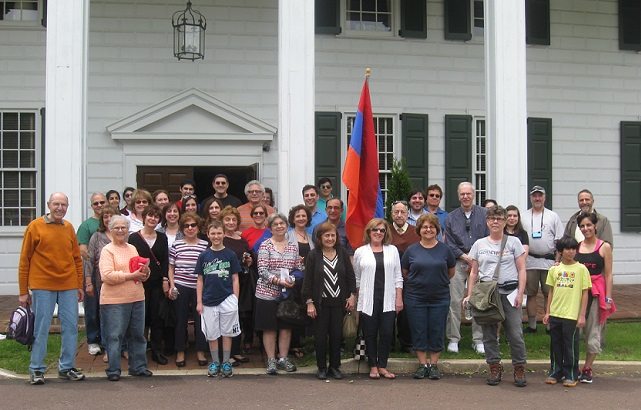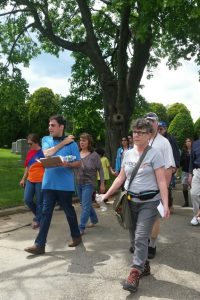Walking Tour Discovers Philadelphia’s Armenian History

A crowd aged 11 to 91 gathered at Arlington Cemetery outside Philadelphia on May 14 to experience a walk through the city’s Armenian history. This is part of a growing trend throughout the diaspora in recent years to rediscover their history and piece together family trees torn apart by the genocide. Thanks to the digitizing of records online and the ability to connect through the internet, new information about the immigration and life of our early Armenian ancestors in America has come flooding to amateur sleuths and historians. This has led to initiatives such as the “Armenian Immigration Project” website which digitizes immigration records of Armenians from the 19th and 20th centuries, and the first ever Armenian Genealogy Conference which was held in Watertown, Mass., in April. The walk in Philadelphia was yet another example of the growing interest in learning about those who came before, creating the diasporan communities we have today.

A crowd aged 11 to 91 gathered at Arlington Cemetery outside Philadelphia on May 14 to experience a walk through the city’s Armenian history.
The first in a series of planned tours, the tour was a walk through Arlington to visit the graves of important figures in Philadelphia’s Armenian-American history, along with some of the notable non-Armenians buried there. Arlington has been a landmark for Philadelphia’s Armenians since 1907, when a major figure from its early history, Rev. Harutune Jenanyan, became the first Armenian buried there. Rev. Jenanyan was the founder of St. Paul’s Institute of Tarsus in Cilicia and traveled throughout the United States giving a speech called “The Suffering Armenians” about the Hamidian Massacres of 1895. He raised money and hosted many refugees at his Philadelphia home.
In the years that followed his death, numerous Armenians followed Rev. Jenanyan’s example by choosing Arlington as a final resting place—numbering more than 3,000 today. The tour, led by local historian Paul Vartan Sookiasian, took participants on an over 1 mile walk from grave to grave, where he told the life stories of notable community members at their tombs. These included Dr. Mihran Kassabian, a pioneer of x-ray studies who alerted the world to their danger, dying in 1910 from radiation exposure due to his studies. Found just a few steps from each other are the graves of Dr. Lucy Gulezian, humanitarian and one of the first female Armenians to get a medical degree in the United States, and that of Karapet Sital, an author and folklorist who was popular in Soviet Armenia, best known for his epic “The Heroes of Kasht”.
The tour also explored unique stones, such as the cemetery’s oldest stone with Armenian lettering inscribed on it from 1913, and one with the figure of mythical hero Sasuntsi Davit carved on it. The group also learned that many of Philadelphia’s earliest Armenians are buried in unmarked mass graves, because as poor immigrants many could not afford stones. A special part of the tour was dedicated to notable non-Armenians buried there, including Miss America 1924, whose career was launched by Armenian photographer John Ivazian. Next to her is the grave of Henry Blank, a wealthy jeweler who survived the sinking of the Titanic, an event that has captured the imagination of the world for over a hundred years now. Buried next to the Temoyan and Jerrehian families of rug-dealers from Dikranagert is English-American Mary Lee, who volunteered as a nurse during the U.S. Civil War and tended to soldiers at many famous battles including Gettysburg and Antietam. The Armenians of Arlington Cemetery made a place in history and are surrounded by history there as well.
The tour ended with a reception featuring Armenian delicacies. The success of this Armenian Tour has created interest for more such events. Another historic Philadelphia cemetery, West Laurel Hill, is planning an Armenian Tour of its own, where Armenians can be found buried amongst the graves of Philadelphia’s most elite and prestigious families. Arlington is also planning for more Armenian Tours due to the demand. Through such initiatives, Philadelphia’s fascinating Armenian history is being brought to light for new generations, making sure their stories will remain alive.
Source: Armenian Weekly Mid-Atlantic

